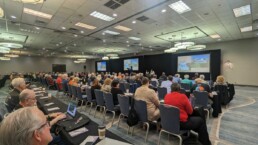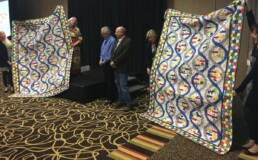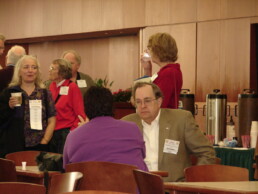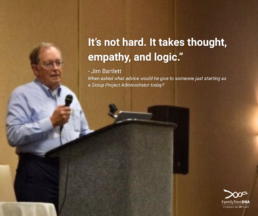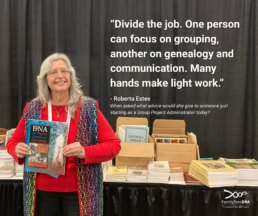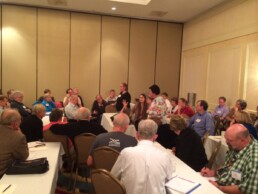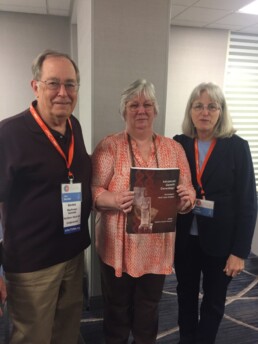By: Courtney Eberhard
To celebrate our 25th anniversary, we asked two of our earliest Group Project Administrators to share their stories.
As FamilyTreeDNA celebrates 25 years of innovation and discovery, we’re reflecting on the people who helped lay the foundation of our community: our Group Project Administrators.
These dedicated volunteers have played a vital role in advancing the field of genetic genealogy. They have built surname projects, guided research, and connected families across generations and continents. In honor of this milestone, several of our earliest Group Administrators, who have been with us since the beginning, shared their reflections, stories, and insights. Their passion and perseverance continue to shape our legacy and inspire the next generation of family historians.
The Early Days of Genetic Genealogy at FamilyTreeDNA
Every journey has a beginning. For our earliest Group Project Administrators, that moment came when genetic genealogy was still in its infancy and so was FamilyTreeDNA.
In 2000, Roberta Estes made a call she wasn’t sure would lead anywhere. She had heard about a company selling Y-DNA tests and left a message out of curiosity. That evening, she received a call back, not from a sales rep, but from Bennett Greenspan, President of FamilyTreeDNA. They talked for over an hour. By the end of the conversation, Roberta had agreed to start the Estes DNA Group Project and ordered five kits for her male cousins. That one call launched a journey that would span decades.
For Jim Bartlett, his path started in 2002 as part of a grassroots effort to trace the Bartlett surname. He organized teams online and built trees to see how researchers were connected. DNA testing provided the missing link. “We wound up with 23 very distinct and different groups,” Jim recalls. “They aligned almost exactly with our Teams.” That alignment validated their research and sparked new directions they never could’ve pursued without genetic evidence.
Both Group Administrators credit those early days with something special: accessibility. Roberta recalls that Bennett himself would answer Group Administrator questions. Jim agrees: “It was unexpectedly GREAT. I could email or call and get an almost immediate response from Bennett or Max. We were learning from each other.”
Breakthroughs, Discoveries, and the Stories That Stay With Us
In the world of genealogy, every match tells a story. Over the years, our Group Administrators have helped thousands uncover theirs.
One of Jim’s most rewarding discoveries came when two seemingly separate lines in the Bartlett Group Project, one with Mayflower roots and another from colonial Virginia, turned out to be related. “Burned counties had kept us from finding their pre-1776 ancestors,” Jim explains, “but Y-DNA at every level showed the two lines were connected.”
Not all surprises were straightforward. In one case, four women tested men from four brother lines born around 1800. Three matched. One didn’t. Jim dug into the records and into a family story. Nine months before one of the brothers was born, the neighbor’s wife had become bedridden. A kind gesture of delivering food turned into a new chapter in their family history. The misattributed parentage was confirmed through DNA, and rather than cause tension, the women embraced the truth and remained friends and BARTLETT researchers to this day.
Roberta’s most emotional moments often involve adoptees. In one case, she helped a man unsure of his biological father identify potential candidates. Months later, he reached out to one of them and received a call in return. “I’m not your father,” the man said, “but I am your uncle.” The cousin had waited too long to reach out—his father had passed—but the uncle invited him to the family reunion, where he was welcomed with open arms. “Their relationship has continued for many years,” Roberta shared. “And now he’s one of our most active project members.”
From Y-25 to Big Y: How DNA Tools Have Transformed Over Time
From paper charts to cutting-edge tools, a lot has changed since the early 2000s. Our Group Administrators have had a front-row seat to it all.
Jim started with Y-25 and Y-37 tests paired with strong traditional genealogy. But today, Big Y testing has taken the Bartlett Group Project further, helping narrow connections back to Plymouth, Massachusetts. “It’s opened up levels of resolution we didn’t have before,” Jim says. He hopes to see FamilyTreeDNA implement automated segment triangulation and clustering to make these tools even more accessible.
Roberta highlights a turning point for all three types of DNA. “Big Y-700 and Y-DNA Discover™ have shifted the focus from being related thousands of years ago to relationships within a genealogical timeframe,” she says. She also notes the power of mitochondrial DNA and mtDNA Discover for uncovering female ancestors whose surnames are often lost. “When this industry first launched, autosomal DNA wasn’t even on the horizon. Now tools like Family Matching and triangulation are changing everything.”
Advice from the Pioneers: What Today’s Group Administrators Can Learn
With decades of experience between them, these Group Administrators have some sage advice for those just beginning their journey.
“It’s not hard. It takes thought, empathy, and logic,” says Jim. “You’ll learn a lot about the surname and become the expert, helping others find their way.”
“Divide the job,” Roberta advises. “One person can focus on grouping, another on genealogy and communication. Many hands make light work.”
What keeps them going? For Jim, it’s the unfinished puzzle. “I want to solve both parts, the chromosome map and the ancestral connection.” He’s mapped over 370 triangulated groups so far. For Roberta, it’s about honoring those who came before. “DNA reaches beyond what records can. Resurrecting their history is how we assure they’re never forgotten.”
What’s Next for FamilyTreeDNA and Genetic Genealogy?
As we celebrate the past 25 years, we also look to the future with curiosity, gratitude, and optimism.
Jim hopes FamilyTreeDNA will implement new tools to automate clustering and triangulation. These features, he says, would make the process easier for all users and help walk ancestral lines back generation by generation.
Roberta is excited about the refinement of the mitochondrial tree and its implications for uncovering unknown ancestors. “I’m hopeful that new features will help identify shared genetic ancestors in match lists,” she says. “That can help identify our unknown ancestors too.”
Have You Been Inspired to Take Part?
Our Group Project Administrators have played an essential role in shaping FamilyTreeDNA’s history. Their passion, discoveries, and dedication continue to fuel our shared mission of exploring family, identity, and connection through DNA.
If you’re passionate about helping others discover their roots and making an impact through DNA, you can become a part of that legacy too.

About the Group Project Administrators
Roberta Estes
Roberta Estes, author of the book, DNA for Native American Genealogy, The Complete Guide to FamilyTreeDNA, and the popular genetic genealogy blog DNAeXplained is also a scientist, National Geographic Genographic affiliate researcher, Million Mito team member, and founding pioneer in the genetic genealogy field.
An avid 40-year genealogist, Roberta has written over 1600 articles at DNAeXplained about genetic genealogy as well as how to combine traditional genealogy with DNA to solve those stubborn ancestor puzzles. Roberta took her first DNA test in 1999 and hasn’t stopped.
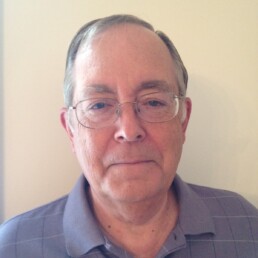
Jim Bartlett
Jim has been an active, researching, genealogist for over 50 years. He took his first DNA test in 2002 to launch the Bartlett Surname Group Project. He has been using autosomal DNA (atDNA) since 2010 – testing at all five major companies. He has validated over 10,000 DNA Matches who descend from most of his ancestry. He built a Chromosome Map of his DNA segments, linking almost all of them to his Ancestors. He is an avid proponent of segment Triangulation, Clustering and other powerful new DNA tools; and enjoys teaching them to other genealogists. He writes a DNA blog, segmentology.org, focused on explaining and using atDNA.
He wrote Chapter 1: Lessons Learned from Triangulating a Genome in “Advanced Genetic Genealogy: Techniques and Case Studies” edited by Debbie Wayne Parker. He contributed to “So Far; Genetic Genealogy; the first 25 years 1999-2024″, by Diahan Southard. Disclaimer: Although a volunteer at several companies, he does not represent, or receive compensation from, any company.

About the Author
Courtney Eberhard
Marketing Coordinator for FamilyTreeDNA
Courtney Eberhard, the Marketing Coordinator at FamilyTreeDNA, is driven by a profound passion for genealogy, fueled by her personal journey as an adoptee with roots in the LDS church. Through research with FamilyTreeDNA, she has also been able to uncover her son’s father’s indigenous roots in Mexico and provide context for his origins.
In her spare time, she finds joy in connecting with her family and friends during cookouts, cheering for the Houston Astros, and cherishing her role as a dedicated full-time parent.
